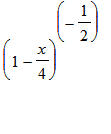Taylor series
| > | restart: |
Se e: Stewart, chapter 11. Maple can find the Taylor series of a function, such as for instance:
| > | taylor(exp(x),x=0); |
![]()
Standard Maple gives the answer till the order:
| > | Order; |
![]()
We can eventually change this by explicitly entering the wanted order:
| > | taylor(exp(x),x=0,10); |
![]()
Or by changing the value of Order first:
| > | Order:=12: taylor(exp(x),x=0); |
![]()
We change Order again to its default value and try to find a Taylor series about x=1 :
| > | Order:=6: taylor(exp(x),x=1); |
![]()
By using Maple we can easily check the Taylor series on the formulae sheet (also see: Stewart, § 11.10):
| > | exp(x)=taylor(exp(x),x=0,4); |
| > | sin(x)=taylor(sin(x),x=0,8); |
| > | cos(x)=taylor(cos(x),x=0,8); |
| > | ln(1+x)=taylor(ln(1+x),x=0,5); |
| > | (1+x)^k=taylor((1+x)^k,x=0,4); |
![]()
![]()
![]()
![]()
![]()
Example 6 of § 11.10:
| > | taylor(x*cos(x),x=0); |
![]()
Example 7 of § 11.10:
| > | taylor(sin(x),x=Pi/3); |

More examples (see: Stewart, § 11.10):
| > | 1/(1-x)=taylor(1/(1-x),x=0); |
| > | arctan(x)=taylor(arctan(x),x=0); |
| > | exp(x)*sin(x)=taylor(exp(x)*sin(x),x=0); |
| > | tan(x)=taylor(tan(x),x=0); |
![]()
![]()
![]()
![]()
Example 1 of § 11.11:
| > | 1/(1+x)^2=taylor(1/(1+x)^2,x=0); |

This is an example of a binomial series , where the following binomial coefficients arise:
| > | for n from 0 to 5 do binomial(-2,n) od; |
![]()
![]()
![]()
![]()
![]()
![]()
Example 2 of § 11.11:
| > | 1/sqrt(4-x)=taylor(1/sqrt(4-x),x=0); |
![]()
If we write
 *
*
 , then we obtain:
, then we obtain:
| > | 1/sqrt(4-x)=1/2*taylor((1-x/4)^(-1/2),x=0); |
![]()
Here the following binomial coefficients arise:
| > | for n from 0 to 5 do binomial(-1/2,n) od; |
![]()
![]()
![]()
![]()
![]()
![]()
| > |